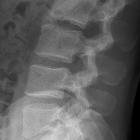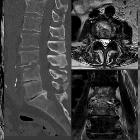Gibbus

Gibbus bei
ventral eingebrochenem unteren BWK. Anamnese unbekannt. In der p.a.-Aufnahme fällt der verminderte kraniokaudale Durchmesser des Thorax auf. In der Seitaufnahme zeigt sich dafür der sagittale Durchmesser erheblich erweitert.

Preschooler
with short stature. AP radiograph of the thoracolumbar spine (left) shows ribs that are widened but then taper at their vertebral insertions (oar-shaped ribs). Lateral radiograph of the thoracolumbar spine (right) shows the vertebral bodies to be hypoplastic and oval in appearance and to be beaked anteriorly, resulting in a gibbus deformity at the thoracolumbar junction. Overall there is diffuse platyspondyly of the spine.The diagnosis was mucopolysaccharidoses type IV – Morquio syndrome.
A gibbus deformity is a short-segment structural thoracolumbar kyphosis resulting in sharp angulation.
Pathology
Etiology
There are a number of causes which can be divided into congenital and acquired.
Congenital
- achondroplasia
- cretinism (congenital hypothyroidism)
- Apert syndrome
- Coffin-Lowry syndrome
- mucopolysaccharidoses
Acquired
- compression fracture / vertebra plana
- osteomyelitis/diskitis
- pyogenic spinal osteomyelitis
- tuberculosis (Pott disease)
- Scheuermann disease
History and etymology
Gibbus is Latin for "hump/hunch" and is related to the descriptor 'gibbous' in relation to phases of the moon.
Siehe auch:

 Assoziationen und Differentialdiagnosen zu Gibbus:
Assoziationen und Differentialdiagnosen zu Gibbus:










